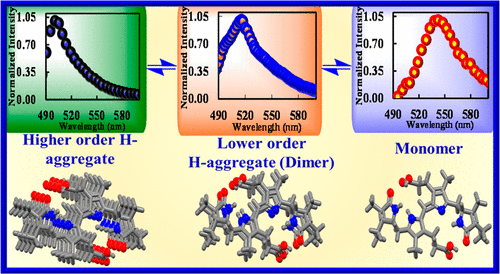当前位置:
X-MOL 学术
›
J. Phys. Chem. A
›
论文详情
Our official English website, www.x-mol.net, welcomes your
feedback! (Note: you will need to create a separate account there.)
Stercobilin and Urobilin in Aqueous Media: Existence of Specific H-Aggregates and Nonspecific Higher Aggregates at Different Concentrations
The Journal of Physical Chemistry A ( IF 2.7 ) Pub Date : 2020-11-19 , DOI: 10.1021/acs.jpca.0c08642 Swayam Prakash 1 , Ashok Kumar Mishra 1
The Journal of Physical Chemistry A ( IF 2.7 ) Pub Date : 2020-11-19 , DOI: 10.1021/acs.jpca.0c08642 Swayam Prakash 1 , Ashok Kumar Mishra 1
Affiliation

|
Fecal matter is considered to be one of the primary sources of water pollution. Understanding the aggregation behavior of the fecal pigments (FPs) could play a critical role in their detection and analysis. This work shows that in aqueous media, the fluorescence of FPs indicates the presence of multiple emitting species, which have been assigned to monomers, lower-order H-aggregates (dimers), and higher-order H-aggregates. Steady-state absorbance, fluorescence and time-resolved fluorescence decay studies conclude that the emission of FPs in aqueous medium indicates H-type of aggregation, even up to nanomolar and sub-nanomolar concentrations. Four sets of independent experiments involving the variation of (i) concentration of FPs, (ii) temperature, (iii) pH, and (iv) ethanol/water composition as solvent media suggest the presence of monomer (540 nm), dimer (516 nm), and higher-order aggregates (500 nm) of FPs in aqueous solutions. The dimeric FP species appear to be present in the entire concentration range of 1 pM to 1 μM. Fluorescence lifetimes of H-aggregates are relatively longer as compared to the corresponding monomers. Hydrogen bonding appears to play an important role in forming H-aggregates in the aqueous phase of FPs as observed in the IR spectra of the FPs in dichloromethane. Density functional theory (DFT) calculations using the B3LYP functional and the LANL2DZ basis set show the contributions of π–π stacking and hydrogen-bonding interactions toward the formation of H-aggregated dimer of FPs in aqueous media.
中文翻译:

水性介质中的Stercobilin和Urobilin:在不同浓度下存在特定的H-聚集体和非特异性的高聚集体
粪便被认为是水污染的主要来源之一。了解粪便色素(FPs)的聚集行为可能在其检测和分析中起关键作用。这项工作表明,在水性介质中,FP的荧光表明存在多种发射物质,这些物质已被分配给单体,低阶H聚集体(二聚体)和高阶H聚集体。稳态吸光度,荧光和时间分辨的荧光衰减研究得出结论,水性介质中FP的发射表明H型聚集,甚至高达纳摩尔和亚纳摩尔浓度。四组独立实验,涉及(i)FP浓度,(ii)温度,(iii)pH,(iv)作为溶剂介质的乙醇/水组合物表明在水溶液中存在FP的单体(540 nm),二聚体(516 nm)和更高阶的聚集体(500 nm)。二聚体FP种类似乎以1 pM至1μM的整个浓度范围存在。与相应的单体相比,H-聚集体的荧光寿命相对更长。如在二氯甲烷中FP的IR光谱中所观察到的,氢键似乎在FP的水相中形成H-聚集体中起重要作用。使用B3LYP泛函和LANL2DZ基集进行的密度泛函理论(DFT)计算显示了π-π堆积和氢键相互作用对水性介质中FP的H聚集二聚体形成的贡献。水溶液中FP的高阶聚集体(500 nm)。二聚体FP种类似乎以1 pM至1μM的整个浓度范围存在。与相应的单体相比,H-聚集体的荧光寿命相对更长。如在二氯甲烷中FP的IR光谱中所观察到的,氢键似乎在FP的水相中形成H-聚集体中起重要作用。使用B3LYP泛函和LANL2DZ基集进行的密度泛函理论(DFT)计算显示了π-π堆积和氢键相互作用对水性介质中FP的H聚集二聚体形成的贡献。水溶液中FP的高阶聚集体(500 nm)。二聚体FP种类似乎以1 pM至1μM的整个浓度范围存在。与相应的单体相比,H-聚集体的荧光寿命相对更长。如在二氯甲烷中FP的IR光谱中所观察到的,氢键似乎在FP的水相中形成H-聚集体中起重要作用。使用B3LYP泛函和LANL2DZ基集进行的密度泛函理论(DFT)计算显示了π-π堆积和氢键相互作用对水性介质中FP的H聚集二聚体形成的贡献。与相应的单体相比,H-聚集体的荧光寿命相对更长。如在二氯甲烷中FP的IR光谱中所观察到的,氢键似乎在FP的水相中形成H-聚集体中起重要作用。使用B3LYP泛函和LANL2DZ基集进行的密度泛函理论(DFT)计算显示了π-π堆积和氢键相互作用对水性介质中FP的H聚集二聚体形成的贡献。与相应的单体相比,H-聚集体的荧光寿命相对更长。如在二氯甲烷中FP的IR光谱中所观察到的,氢键似乎在FP的水相中形成H-聚集体中起重要作用。使用B3LYP泛函和LANL2DZ基集进行的密度泛函理论(DFT)计算显示了π-π堆积和氢键相互作用对水性介质中FP的H聚集二聚体形成的贡献。
更新日期:2020-12-03
中文翻译:

水性介质中的Stercobilin和Urobilin:在不同浓度下存在特定的H-聚集体和非特异性的高聚集体
粪便被认为是水污染的主要来源之一。了解粪便色素(FPs)的聚集行为可能在其检测和分析中起关键作用。这项工作表明,在水性介质中,FP的荧光表明存在多种发射物质,这些物质已被分配给单体,低阶H聚集体(二聚体)和高阶H聚集体。稳态吸光度,荧光和时间分辨的荧光衰减研究得出结论,水性介质中FP的发射表明H型聚集,甚至高达纳摩尔和亚纳摩尔浓度。四组独立实验,涉及(i)FP浓度,(ii)温度,(iii)pH,(iv)作为溶剂介质的乙醇/水组合物表明在水溶液中存在FP的单体(540 nm),二聚体(516 nm)和更高阶的聚集体(500 nm)。二聚体FP种类似乎以1 pM至1μM的整个浓度范围存在。与相应的单体相比,H-聚集体的荧光寿命相对更长。如在二氯甲烷中FP的IR光谱中所观察到的,氢键似乎在FP的水相中形成H-聚集体中起重要作用。使用B3LYP泛函和LANL2DZ基集进行的密度泛函理论(DFT)计算显示了π-π堆积和氢键相互作用对水性介质中FP的H聚集二聚体形成的贡献。水溶液中FP的高阶聚集体(500 nm)。二聚体FP种类似乎以1 pM至1μM的整个浓度范围存在。与相应的单体相比,H-聚集体的荧光寿命相对更长。如在二氯甲烷中FP的IR光谱中所观察到的,氢键似乎在FP的水相中形成H-聚集体中起重要作用。使用B3LYP泛函和LANL2DZ基集进行的密度泛函理论(DFT)计算显示了π-π堆积和氢键相互作用对水性介质中FP的H聚集二聚体形成的贡献。水溶液中FP的高阶聚集体(500 nm)。二聚体FP种类似乎以1 pM至1μM的整个浓度范围存在。与相应的单体相比,H-聚集体的荧光寿命相对更长。如在二氯甲烷中FP的IR光谱中所观察到的,氢键似乎在FP的水相中形成H-聚集体中起重要作用。使用B3LYP泛函和LANL2DZ基集进行的密度泛函理论(DFT)计算显示了π-π堆积和氢键相互作用对水性介质中FP的H聚集二聚体形成的贡献。与相应的单体相比,H-聚集体的荧光寿命相对更长。如在二氯甲烷中FP的IR光谱中所观察到的,氢键似乎在FP的水相中形成H-聚集体中起重要作用。使用B3LYP泛函和LANL2DZ基集进行的密度泛函理论(DFT)计算显示了π-π堆积和氢键相互作用对水性介质中FP的H聚集二聚体形成的贡献。与相应的单体相比,H-聚集体的荧光寿命相对更长。如在二氯甲烷中FP的IR光谱中所观察到的,氢键似乎在FP的水相中形成H-聚集体中起重要作用。使用B3LYP泛函和LANL2DZ基集进行的密度泛函理论(DFT)计算显示了π-π堆积和氢键相互作用对水性介质中FP的H聚集二聚体形成的贡献。











































 京公网安备 11010802027423号
京公网安备 11010802027423号